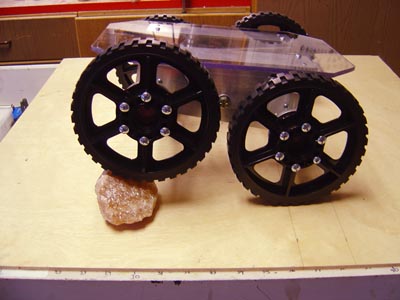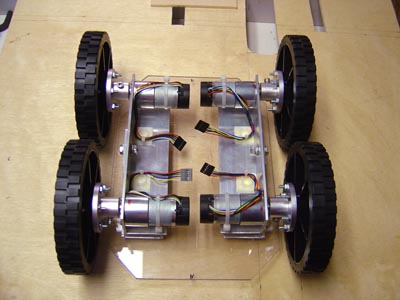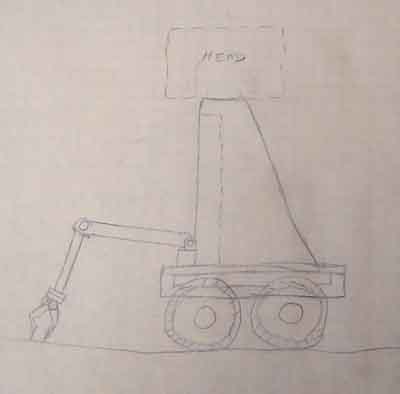
Outdoor Traversing Autonomous Robot
For evaluating outdoor navigation, movements, and functions.
 Above: The robot base with articulating wheels and lexan platform. Details below.
Updated 6/16/18
Key Search Words: ROBOT, ROBOTICS, ROBOTIC VISION, ARTIFICIAL INTELLIGENCE, AI
Above: The robot base with articulating wheels and lexan platform. Details below.
Updated 6/16/18
Key Search Words: ROBOT, ROBOTICS, ROBOTIC VISION, ARTIFICIAL INTELLIGENCE, AI

|
This robot style
has a design that for me has roots dating back 45 years. Yes,
I have been designing autonomous robots for that long! Back when
I was 14 years old, one design concept that kept reoccurring
for me was an outdoor robot with a four wheel mobility base,
topped by a rectangular tower like body with a head and mechanical
arm. I was determined that someday - When I was considerably
more intellectually capable - to actually construct such a fantastic
robot. Since then, I have built countless robots but none have
actually come to resemble the design in my mind when I was 14.
Now
it is time.
Here is a scan
of the original drawing I made when I was 14 to give you the
basic concept. (Yes, I have every single drawing of robots I
made as a child!)
 1973
1973
|
While
quite fanciful in details, the idea was to construct a moving
high traction base to enable the robot to drive well outdoors
in rocks, grass and weeds. On top a rectangular box like body
with slots, readouts, and lights. A frontal articulating arm
with gripper allowed grabbing weeds, rocks, etc. Something resembling
a soil coring device is on the rear. And most importantly, the
robot has a real head! This will be the overall scheme for our
new robot. "Mobot I" (what an awful name) will in a
sense finally become a reality after 46 years.... |
Click
the thumbnails below for a larger image:
 | The
base must articulate in such a way as to keep all four wheels
touching the ground most of the time. To do this, each pair of
motors on a side is mounted on a frame that tilts relative to
the main platform. This allows the far set of wheels to be flat
on the ground and driving the robot forward, while the side closest
to you to drive over say a rock up to 2 inches height and still
connect with the surface for good traction. |
 | The
robot is essentially a foot square and has a lexan top plate
to put the rest of the robot on. This is the mobility platform
only at this point. The robot steers by what is called "skid
steering". This tank like driving technique drives the robot
forward by turning all four wheels in one direction. To turn,
it rotates on its center by turning one set forward, while the
other set goes in reverse. As long as the robots body is fairly
wide like here, this works well and is especially suitable for
outdoor robots. The rubber coated high traction wheels are six
inches in diameter and driven by a quad set of Polulu DC motors
with Hall sensor encoders. They are 50 rpm at 12 volts. The fastest
this robot will move is about 75 feet in one minute. |
 | The
underside shows the four motors with 100:1 gear reduction mounted
on the articulating L channel. |
 | Here
is a foamboard mock up to test the dimensions for the tower assembly.
This frontal view shows the cut out for the arm to be stowed,
with the moveable doors left off. A plastic half dome for a head
is shown. |
 | The
rear view shows the opening (door off) that will allow access
to the inside of the tower where the electronics are to be housed. |
 |
This ghostly
image is a possible appearance of the robot that will sit on
the mobility platform. The only details at this point are a storable
articulating arm with 3D printed components, a tapered monolithic
tower for a body, and "something" amazing for its head...
Stay tuned!
|
|
Previous Uploads on this robot:
NONE YET...
 HOME
HOME


Above: The robot base with articulating wheels and lexan platform. Details below. Updated 6/16/18 Key Search Words: ROBOT, ROBOTICS, ROBOTIC VISION, ARTIFICIAL INTELLIGENCE, AI

HOME